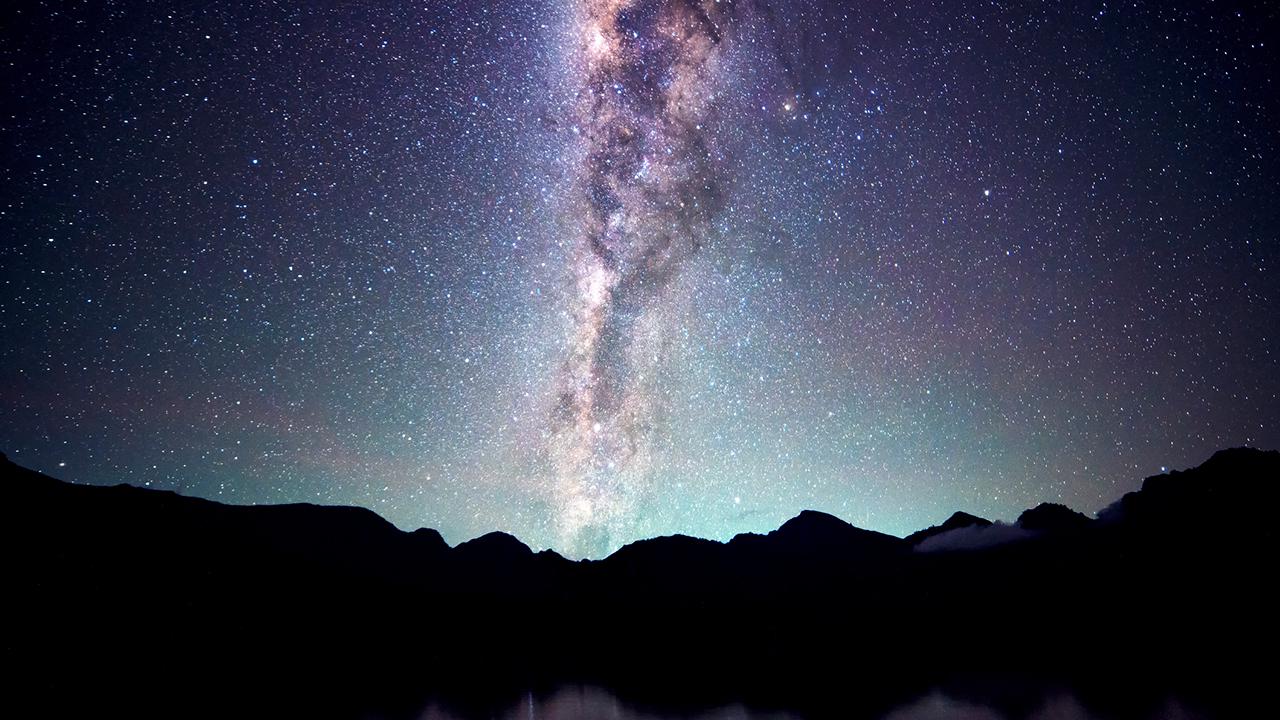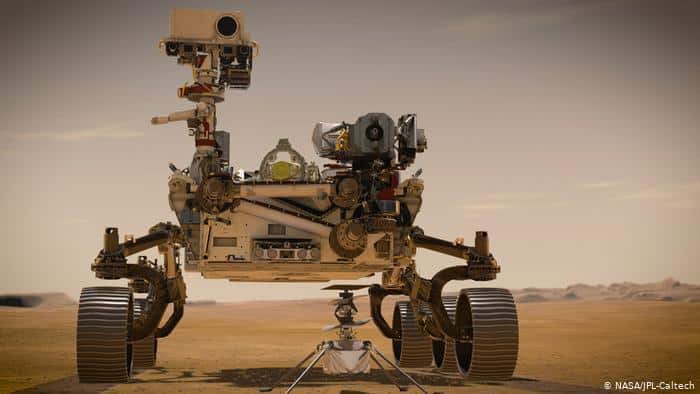

Milkyway from Segara Anak - Rinjani Mountain. Abdul Azis / Moment / Getty Images
By Dirk Lorenzen
2021 begins as a year of Mars. Although our red planetary neighbor isn’t as prominent as it was last autumn, it is still noticeable with its characteristic reddish color in the evening sky until the end of April. In early March, Mars shines close to the star cluster Pleiades in the constellation Taurus.
But for space nerds, Mars is already the center of attention in February. Three space probes that were launched in the summer of 2020 will arrive on the red planet.
On February 9, “Hope,” the first interplanetary mission of the United Arab Emirates, is set to enter orbit around Mars. Only one day later, the Chinese probe Tianwen-1 will join it. The name means “heavenly questions,” referring to a famous piece of ancient poetry.
Both missions will take surface and atmospheric measurements of Mars. Probably in May, a small rover will detach from the Chinese spacecraft and make its way down to the surface to explore the surroundings of the landing site.
A Landing Like a James Bond Movie

NASA’s Mars 2020 Perseverance rover (shown in artist’s illustration) is the most sophisticated rover NASA has ever sent to Mars. Ingenuity, a technology experiment, will be the first aircraft to attempt controlled flight on another planet. Perseverance will arrive at Mars’ Jezero Crater with Ingenuity attached to its belly. NASA
The highlight of this year’s Mars exploration is the landing of the NASA rover “Perseverance” on February 18. Once the spacecraft enters the atmosphere it will be slowed down by friction. The heat shield will surpass 1,000 degrees Celsius. Later, parachutes will deploy to slow it down even more. Roughly two kilometers above the planet’s surface, a sky crane comes into play. Four thrusters keep the crane properly oriented.
The rover is connected to the crane by nylon tethers. Upon approach of Mars’ surface, the sky crane will lower Perseverance down about 7 meters. Once the rover has touched down, the tethers are cut and the sky crane flies off to land somewhere else on the surface.
Entry, descent and landing takes just seven minutes – the so-called seven minutes of terror. The flight team can’t interact with the spacecraft on Mars. Experts have to sit and watch what’s happening more than 200 million kilometers away. Radio signals from the spacecraft need about 11 minutes to travel in one direction. When the control center in Pasadena, California receives the message that entry has begun, Perseverance will already be on the ground. There is only one chance for a smooth landing. Any error could mean the mission is lost. The audacious sky crane maneuver would be a great feat in any action movie. But NASA knows how to do it – the Curiosity rover landed with a sky crane in 2012.
Life on Mars?
Scientists want to use Perseverance to explore whether there is or ever has been life on Mars. Today the planet is a hostile environment – dry and cold with no magnetic field shielding the harsh radiation from space. Life as we know it can’t survive on the Martian surface right now. But billions of years ago, Mars was hotter and wetter and had a shield against radiation. So it is at least plausible that simple microbes developed there. Maybe they live in the soil now, one or two meters below the surface. Perseverance will collect samples to find out. A future mission by NASA and the European Space Agency (ESA) will pick up the samples and return them to Earth. But this won’t happen before 2030.
The Long Wait for James Webb

The Hubble Space Telescope has been orbiting the Earth for more than 30 years. NASA
The Hubble Space Telescope’s images of planets, nebulae, star clusters and galaxies are legendary. The cosmic eye, launched in 1990, is likely to fail towards the end of this decade. The James Webb Space Telescope will be its successor. It is scheduled to launch on October 31 with a European Ariane 5 rocket from the Kourou spaceport in French Guiana.
The launch date is about 14 years later than planned when the project began in 1997. At almost billion (€8.2 billion), the telescope is more than ten times as expensive as originally conceived. Its namesake James Webb was the NASA administrator during the height of the Apollo project in the 1960s.
Astronomers expect completely new insights from James Webb Telescope images, such as how the universe came into being, how it developed and how galaxies, stars and planets are formed. The instrument will observe the earliest childhood of the cosmos and photograph objects that already existed in the universe 200 to 300 million years after the Big Bang. James Webb, as the experts call the telescope for short, may even provide information about possibly inhabited exoplanets – planets like ours orbiting stars other than the Sun.
A Sensitive German Camera

The fully assembled James Webb Space Telescope with its sunshield and unitized pallet structures that will fold up around the telescope for launch. NASA
The mirror of the James Webb Space Telescope is 6.5 meters in diameter and consists of 18 hexagonal segments. The entire instrument unfolds in 178 steps over a period of several months. Only then – probably in the spring of 2022 – will we see its first images.
Many communication or reconnaissance satellites only unfold in space. However, not every micrometer is as important as with this telescope.
NIRSpec, one of the four cameras on board, was built at Airbus in Ottobrunn near Munich. It is made of an unusual material: ceramic. Both the basic structure and the mirrors are made of this very light, hard and extremely temperature-insensitive material. With good reason – the large camera has to withstand a lot in space. It is cooled to around -250 degrees Celsius in order to register the weak infrared or thermal radiation from the depths of space. Plastic or metal bend and lead to blurred images. Ceramic, on the other hand, remains in perfect shape.
The NIRSpec instrument will examine, among other things, emerging stars and distant galaxies. The ceramic camera is incredibly sensitive – it could register the heat radiation from a burning cigarette on the Moon. Thanks to this precision, astronomers will get completely new insights into the cosmos with the James Webb Telescope and NIRSpec.
No Flight to the Moon but to the ISS
It’s not very likely that the Orion spacecraft from NASA and ESA will start its maiden voyage to the Moon before the end of 2021. As part of the Artemis-1 mission, it will remain in space for four weeks and will orbit the Moon for a few days. There will be no crew on board for the first flight, but two dummies from the German Aerospace Center, which use thousands of sensors to measure the conditions that human beings would be exposed to. The Orion capsule comes from NASA, while the ESA supplies the service module. The service module, which is being built by Airbus in Bremen, provides propulsion, navigation, altitude control and the supply of air, water and fuel. After problems with an engine test in mid-January, the new NASA large rocket Space Launch System (SLS), with which Orion is supposed to be launched, is unlikely to be operational until early 2022.
Matthias Maurer from Saarland is scheduled to fly to the International Space Station (ISS) in October. The flight will be in a Crew Dragon capsule from Cape Canaveral. Maurer will live and work in the orbital outpost for six months. He is currently training to work on numerous scientific experiments. Maurer will be the twelfth German in space.
So far, Germany has only sent men into space. In mid-March, ESA will start the next application process for astronauts. A few years ago, the private initiative Die Astronautin (“She is an astronaut”) showed that there are numerous excellent female applicants.
Two Lunar Eclipses
Even if there is no flight to the Moon, sky fans are looking forward to two eclipses this year. On May 26, there will be a lunar eclipse between 9:45 and 12:53 UTC. From 11:10 to 11:28 UTC, the Moon will be completely in the Earth’s shadow. It can then only be seen in a copper-red light. This is sunlight that is directed into the Earth’s shadow by the Earth’s atmosphere – reddish, like the sky at sunset. This eclipse can be observed throughout the Pacific, and will be best viewed in Australia, New Zealand, Hawaii, and Antarctica. In Europe, the Moon will be below the horizon and therefore the eclipse will not be visible.
This also the case for the partial lunar eclipse on November 19. From 07:18 to 10:47 UTC, the Moon will be partly in the shadow of the Earth. In the middle of the eclipse (around 9:03 UTC) 98% of the Moon will be eclipsed. The spectacle will be best seen in North America, Greenland, East Asia and much of the Pacific, such as Hawaii and New Zealand.
Two Solar Eclipses: One Annular, One Total
In 2021, the Moon will pass right in front of the sun, twice. On June 10, the moon will be nearly in the furthest point of its elliptical orbit around Earth. So it will be too small to cover the sun completely. In the middle of this eclipse, an annulus of the sun will remain visible. The sun’s ring of fire appears between 9:55 and 11:28 UTC for a maximum of four minutes – but it will only be visible in the very sparsely populated areas of northeast Canada, northwestern Greenland, the North Pole and the far east of Siberia.
In the North Atlantic, Europe and large parts of Russia, an eclipse will be seen at least partially. Between 8:12 and 13:11 UTC, the Sun will appear like a cookie that has been bitten into as the Moon covers parts of the bright disk. In some places, the eclipse will last about two hours. In Central Europe, a maximum of one-fifth of the sun will be covered.
Dark Sun Over Antarctica
The celestial event of the year will be a total solar eclipse on December 4. In a 400-kilometer-wide strip, the New Moon will cover the sun completely. For a maximum of one minute and 54 seconds, day will turn to night. For that short time, the brightest stars can be seen in the sky and the flaming solar corona can be seen around the dark disc of the Moon.
Unfortunately, hardly anyone will get to see this cosmic spectacle because the strip of totality only runs through the Southern Ocean and the Antarctic. From 7:03 to 8:04 UTC the umbra of the Moon moves across the Earth’s surface – and perhaps some ships’ crews will enjoy the solar corona.
Only during the few minutes of totality is it possible to look safely at the Sun with the naked eye. During the partial phase or in the case of an annular eclipse, suitable protective goggles are necessary to watch the spectacle. Normal sunglasses are not safe. Looking unprotected into the sun can lead to severe eye damage or even blindness.
Two Giant Planets in Northern Summer and Southern Winter
Venus, our other neighboring planet, will be behind the sun on March 26. It is not visible for the first few months of the year. From the end of April through Christmas, it will be visible as an evening star in the sky after sunset. The planet, shrouded in dense clouds, is the brightest object in the sky after the Sun and the Moon. The best visibility will be from September to December.
The giant planet Jupiter is in its best position of the year on August 20. It then shines in the constellation Capricorn, only disappearing from the evening sky at the beginning of next year. The ringed planet Saturn is also in the constellation Capricorn and can be observed particularly well on August 2.
Jupiter and Saturn are the stars of summer in the Northern Hemisphere and those of the long winter nights in the Southern Hemisphere. They are in the same area of the sky, almost forming a double star with Jupiter being the brighter of the two.
Shooting Stars in August and December
There are certain periods when the Earth crosses the orbital path of a comet and shooting stars are much more likely than on other nights. Many small stones and dust particles are scattered on comet orbits, which light up the Earth’s atmosphere for a moment when they enter.
The Perseids are particularly promising: August 9-13, a few dozen meteors (the technical term for shooting stars) will scurry across the sky per hour. The traces of light will seem to come from the constellation Perseus, near the striking celestial W of Cassiopeia. The Geminids – meteors coming from the constellation Gemini – will be similarly exciting with up to 100 shooting stars per hour, December 10-15.
Reposted with permission from Deutsche Welle.
- What 21 Stars Reveal About the Universe - EcoWatch
- Earth Is Spinning Faster Than Ever - EcoWatch
- Artemis, Orion and the Quest to Get Humans to the Moon Again - EcoWatch
- Three Mars Missions Arriving in February 2021 - EcoWatch
- Supermoon! Red Blood Lunar Eclipse! It's All Happening at Once, But What Does That Mean?
- How to Watch the 'Ring of Fire' Solar Eclipse This Week
- How to Watch the Longest Partial Lunar Eclipse in 580 Years - EcoWatch

 233k
233k  41k
41k  Subscribe
Subscribe 